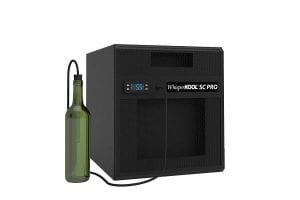The Best Wine Cellar Cooling System
We looked at the top 3 Wine Cellar Cooling Systems and dug through the reviews from 7 of the most popular review sites including and more. The result is a ranking of the best Wine Cellar Cooling Systems.

Our Review Process
Don't Waste Your Money is focused on helping you make the best purchasing decision. Our team of experts spends hundreds of hours analyzing, testing, and researching products so you don't have to. Learn more.
Our Picks For The Top Wine Cellar Cooling Systems
The WhisperKOOL SC PRO 4000 Wine Cooling Unit packs in the latest technology to provide efficient, high-quality airflow for your wine cellar. You can cool an area up to 1000 cubic square feet in size using only 3.7 amps of power. It also includes a condensate management system to reduce moisture.
Energy EfficientThe WhisperKOOL SC PRO 4000 Wine Cooling Unit includes an expansion valve that improves airflow efficiency, saving energy while it cools.
With the Breezaire WKL 1060 Wine Cooling Unit Wine Cellar, you can cool areas between 100 and 2000 cubic feet, but it's at its best in smaller spaces. This cooling unit is built with top-quality components to ensure it lasts, but it also comes with a 5-year warranty. The unit is both compact and self-contained to ensure it fits discreetly in smalle...
Great for Wine ClosetsThe Breezaire WKL 1060 Wine Cooling Unit Wine Cellar can squeeze into wine closets, making it the perfect choice for small spaces.
The WhisperKOOL Platinum Split System Wine Cellar Cooling Unit is part of WhisperKOOL's line of extremely quiet systems. It can cool an area up to 1,000 cubic feet, but it's at its best at up to 500 cubic feet. An included liquid bottle probe lets you test the contents of your bottles to ensure they're being cooled properly.
Quiet OperationYou won't have to worry about a noisy wine cellar with the WhisperKOOL Platinum Split System Wine Cellar Cooling Unit.
Buying Guide
If you love a delicious glass of wine, you probably also know the flavor breakdown that happens as the temperature rises. Temperatures as low as 70 degrees can begin to age a wine too quickly, and even higher temperatures can lead to “cooked” wine, which spoils it.
For best results, your wine should be stored at a temperature no lower than 45 degrees Fahrenheit and no higher than 65 degrees Fahrenheit. The perfect temperature is said to be 55 degrees, although you shouldn’t stress yourself out trying to achieve that exact number at all times. Something within that range will be fine.
Casual wine drinkers will be fine relying on the refrigerator. A casual drinker buys a bottle and drinks it within days of opening, or weeks if it’s unopened. But that’s not a solution to rely on for more than a few months at a time. That means if you plan to collect wine, you’ll need a way to keep your wine fresh.
To create the ideal storage conditions for your bottles, you’ll need a dark, cool place. Like heat, light is also the enemy, especially the ultraviolet light that comes from the sun and fluorescent bulbs. For long-term storage, you’ll also need to store the bottles on their sides to prevent the corks from drying out. Otherwise, you can store the bottles horizontally or vertically.
Whether your chosen area is a cellar, basement, or closet, experts recommend bringing an expert to conduct an assessment before you turn it into a formal wine cellar. This will help identify whether you need ductwork, insulation or darkening of windows to create the ideal conditions. But you can also assess the environment yourself and determine whether you can, indeed, achieve the ideal 55-degree temperatures and dark environment necessary to store wine.
“The cellar’s environment is absolutely crucial in maintaining the delicate balance of temperature and humidity so a collection can be properly stored and aged,” says home expert Vicki Liston. “If the room is too dry, the corks shrink and air can get inside the bottles. Too much humidity and the corks can mold. Perfect wine equilibrium can be accomplished with a wine cellar cooling system. ”
One final thing you’ll need to do before you shop is determine the size of the area you’ll need to cool. The storage space you’ll require depends on the size of the collection you plan to have. Most wine cellar cooling systems can handle an area of up to 1000 cubic feet, but experts recommend keeping the area to 500 square feet or smaller, if only to reduce the cost of cooling the space.
Our Expert Consultant

Home Improvement Expert
Vicki Liston writes, produces, and narrates “On The Fly…DIY,” an award-winning home improvement and DIY show of unique project tutorials for the casual DIY’er.
Home improvement and all things DIY have been Liston’s passion since she bought her first house in 2007 and she started making video blogs in 2014. She’s performed hundreds of DIY projects, from small ones to major, wall-smashing renovations and can teach you how to make a trendy DIY barn door for cheap. The proceeds earned from “On The Fly…DIY” are donated to no-kill animal shelters and rescue organizations.
Why we recommend these wine cellar cooling systems?
Products Considered
Products Analyzed
Expert Reviews Included
User Opinions Analyzed
Our experts reviewed the top 3 Wine Cellar Cooling Systems and also dug through the reviews from 7 of the most popular review sites including and more. The result is a ranking of the best of the best Wine Cellar Cooling Systems.
DWYM is your trusted roduct review source. Our team reviews thousands of product reviews from the trusted top experts and combines them into one easy-to-understand score. Learn more.
What to Look For
- You’ll have two major choices when you begin looking for a cooling system for your wine cellar: ducted split versus ductless split. A ducted-split system requires ductwork to be installed, which adds an expense to the process. But with this type of system, you can install the cooling unit in an adjacent room and keep it out of the way.
“Aptly named, ducted systems utilize ducts to move air into your wine cellar,” says Liston. “These are more aesthetically pleasing, as the unit itself can be mounted (and hidden) elsewhere and won’t take up room in the cellar. Ducted systems also protect your collection from vibrations, which can negatively affect the wine’s value, and you won’t have to talk over any operational noise.”
- Also make sure your cellar is well insulated to keep your system from having to do extra work.
- Capacity will vary dramatically from one system to another. Measure the area where it will be used and make sure you choose a unit that can handle that room size.
- One hazard of the environment you create with a wine cellar is condensation. This likely won’t affect the wine itself — in fact, it can help keep your corks from drying out. But it can damage the labels, which will be a big problem if you’re a collector. But far more dangerous is mold, which can begin to damage your bottles, particularly the corks. Look for a cooling system that includes condensation management to reduce this risk.
- As you’re assessing your wine storage needs, consider where you’ll store your cooling system. Some are designed to slide into a cabinet or closet, where they’ll be safely out of view. You can also find some that come with mounts so that you can hang them on the wall.
- In addition to capacity, pay close attention to the power requirements of your chosen cooling unit. Some draw plenty of amps, which means you’ll see a higher utility bill. An efficient wine cellar cooling unit can save you money.
- A cooling unit with a thermostat can help you keep an eye on how efficient your cooling unit is. Some have this mounted directly on the system itself.
- Noise may be a factor, depending on the location of your wine storage. Some cooling systems operate with very little noise, which can keep your environment quiet.
- Durability is also a consideration. Spending a little extra for a cooling system built with top-quality materials can keep you from having to replace it in a few years. Also pay attention to the warranty on the cooling system you choose.
- If you aren’t having your cooling system professionally installed, make sure the wiring in your wine storage area will support the voltage of the unit you choose.
- There are tools you can buy to monitor the internal temperature of the wine you’re storing. Some cooling systems even come with a probe that helps with this.
- Some units promise to improve the airflow efficiency in the area in which they’re kept. This can be especially useful if this improvement is done without using excess power.
- Safety is a consideration with any appliance. Look for a cooling system that has a control built-in that will shut the unit off if conditions become unsafe, such as a blockage or a fan failure.
More to Explore
The cooling of wine cellars come in two major forms: active and passive. With an active wine cellar, you use manmade appliances like air conditioners to keep the area cool. A passive wine cellar uses the natural cooling that comes from being located underground to keep wine cool. Unless you’re building a house, chances are you won’t have a choice as to the type of wine cellar you have. You’ll need an underground, windowless area to achieve true passive cooling. Active wine cellars can be set up anywhere, including a large closet within your home. It’s important, if you have a passive wine cellar, that you closely monitor temperatures, as you may experience fluctuations, requiring the use of a cooling system to supplement what’s occurring naturally.
















